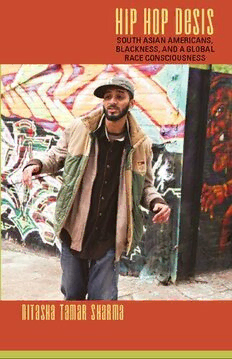
Hip Hop Desis: South Asian Americans, Blackness, and a Global Race Consciousness PDF
Preview Hip Hop Desis: South Asian Americans, Blackness, and a Global Race Consciousness
Hip Hop Desis Refiguring American Music A series edited by Ronald Radano and Josh Kun Charles McGovern, contributing editor Nitasha Tamar Sharma Hip Hop Desis South Asian Americans, Blackness, and a Global Race Consciousness Duke University Press Durham and London 2010 © 2010 Duke University Press All rights reserved Printed in the United States of America on acid- free paper ∞ Designed by C. H. Westmoreland Typeset in Quadraat by Tseng Information Systems, Inc. Library of Congress Cataloging- in- Publication Data appear on the last printed page of this book. Duke University Press gratefully ac- knowledges the support of the North- western University Research Grants Committee, which provided funds toward the production of this book. frontispiece: Deejay Bella spins at a 4th of July event. Photograph courtesy of Deejay Bella. This book is dedicated with eternal love to my parents, Miriam and Jagdish Sharma, to Makaya McCraven with love for his unending support and brilliance, to the South Asian American hip hop artists who make much more than music, and to Ronald Takaki, who made generations of activist scholars Contents Preface ix Acknowledgments xiii Introduction: Claiming Space, Making Race 1 1 Alternative Ethnics: Rotten Coconuts and Ethnic Hip Hop 37 2 Making Race: Desi Racial Identities, South Asian and Black Relations, and Racialized Hip Hop 88 3 Flipping the Gender Script: Gender and Sexuality in South Asian and Hip Hop America 138 4 The Appeal of Hip Hop, Ownership, and the Politics of Location 190 5 Sampling South Asians: Dual Flows of Appropriation and the Possibilities of Authenticity 234 Conclusion: Turning Thoughts into Action through the Politics of Identification 283 Notes 301 References 315 Index 335 Preface The lives of South Asians in America, or desis—a term meaning “of the land” from the Hindi/Urdu word desh, or country—are both historically constituted and circumscribed by global processes and the limitations of what is possible today. Yet some members of this community, such as South Asian American hip hop artists, take active roles in their surroundings by disrupting seemingly fixed ideologies in order to generate new possibilities. In chapter 1 of this volume, “Alternative Ethnics,” I explore the artists’ ambivalent relationships to ethnicity and the influence of South Asian par- ents and peers from recollections of their childhood and college experiences. While nearly half of the artists grew up in middle- class, mostly White neighborhoods (as most desis do) where they have contended with racism from a young age, the other half came from racially and class-diverse neighborhoods in which they grew up alongside Blacks and participated in creating hip hop culture. Thus, class alone does not explain who becomes a hip hop artist; however, where the artists grew up had broad implications for their interactions with Blacks and their experiences with racism. I illustrate the critique by these artists of expectations of ethnic au- thenticity expressed within American South Asian communities as hegemonic notions of desiness—that is, as conservative responses to displacement, racism, and a desire to fit high up in American society. Their production of “ethnic hip hop” illustrates a process of sampling. These individuals turn toward alternatives by rejecting not only
